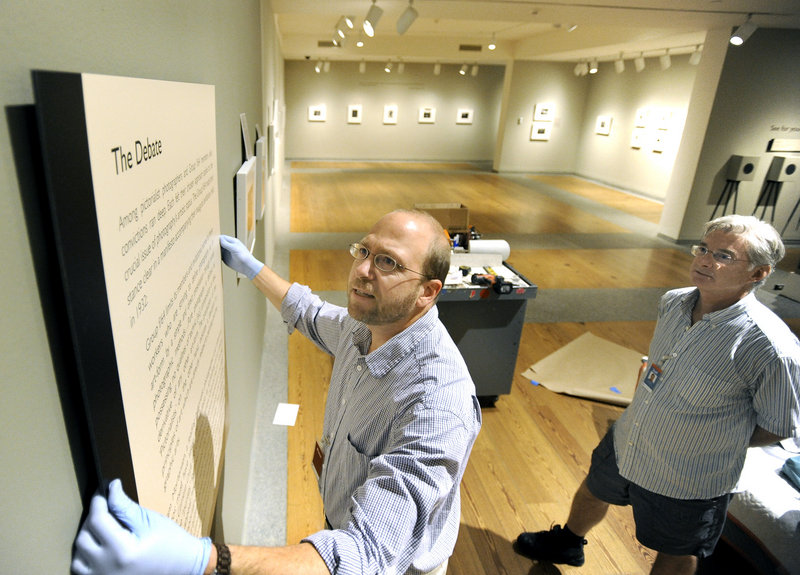PORTLAND – The idea of working with the men who hang and arrange the art at the Portland Museum of Art intimidated me.
I am a well-documented klutz — always burning my fingers on baking pans, always banging my head on overhead lighting, always just plain dropping things. So I was a little worried about helping out at a job where handling valuable art was part of the job description.
That’s why I felt relieved when Greg Welch, chief preparator at the museum, told me his immediate project was cutting paper wall labels that would identify and describe photographs in a show titled “Debating Modern Photography: The Triumph of Group f/64” (showing now through Dec. 5).
But when we began, Welch told me I needed to roll out this very sticky adhesive paper and mount the label to it before cutting the label to size. He warned me not to botch it or waste the sticky stuff in any way, since it costs about $300 a roll.
“And if it doesn’t lay flat, we can’t use it, and I have to call upstairs and have them print out another label, and that’s embarrassing,” said Welch.
So, with cost and embarrassment on my mind, I laid the label on the sticky stuff and managed to press it nice and flat, no wrinkles. Then I stuck it to some thicker backing material (mat board). Welch told me to cut the mat board to fit the label using a box cutter. This was thick stuff, he told me, so I had to use the right amount of pressure. If the cut wasn’t clean, the label could look ragged.
My first cut wasn’t bold enough, and I needed a second cut to get it clean.
Then we had to bring the labels over to a large mat-cutting station, where I had to line the label up and cut perfectly straight edges using a long fixed blade.
Even though I had initially worried about handling art, I now worried about all the blades down here in the preparator’s basement workroom.
Who knew hanging art could be so stressful?
‘TECHNIQUE IS EVERYTHING’
Welch also had me cut some glass — used for framing art — with a wall-mounted glass cutter. He placed a pane of glass on the upright holder and told me to press hard on the handle of the blade and pull it down the length of the glass.
His last bit of advice: “The secret to cutting glass is to have no respect for it.”
So I grabbed the handle as hard as I could and thrust the blade downward with all my might. The pane shattered like I had thrown a baseball through it.
“Like a lot of things we do here, technique is everything,” said Welch.
Welch and fellow preparator Kris Kenow are responsible for packing, unpacking, hanging, labeling, displaying and lighting all the art in the museum’s galleries. Yes, they need a light touch, but they also use an array of skills I didn’t quickly associate with handling art.
They do a lot of cutting, they build cabinets and display pedestals, they cut and create metal screens and filters for just the right lighting, they hang the lights and, of course, they hang the art.
That last task requires lots of math, I found out.
After we got some labels cut, Welch took me upstairs to the main gallery, where the show was already mostly installed. The first public showing would be at 5 that night, and there was still lots to be done.
“When I take you up there, you might freak out when you see what it looks like,” Welch said.
I saw tape and paper on the walls. I saw carts full of tools and half-done lighting fixtures. I saw a giant hydraulic lift in the middle of the floor with traffic cones around it.
But Welch, who has been doing this for 35 years, saw a manageable amount of work and did not seem worried.
We began to hang text panels — big matted panels with information about the show.
That’s when I found out about the math.
And I was never very good at math.
SAVING ARTWORK FOR THE FUTURE
Welch had me measure the length of the panel, the distance from where it would be hung to the bottom of the panel, and the bottom of the panel to the floor.
Maybe there were a couple other measurements as well. I’m not sure, because math makes my head ache.
Then he had me add two measurements — 35½ inches plus 34 7/8 inches. I got 80 11/8 inches. About 10 inches and one strange made-up number too many.
“If we had hung it to your measurements, it would have been about 10 inches too high,” said Welch.
Then Welch showed me a cart full of lighting fixtures he was preparing. There were floodlights of all shapes and sizes, including one he said could be used as a train’s headlight.
Welch, who has a fine arts degree and studied painting, has made lighting his specialty over the years. He loves using his hands, tools and creative eye to create lighting that is just perfect for the art.
“I like to look at us as conservationists,” he said, “that our safe handling and care makes it possible for people to continue to enjoy these works far into the future.”
Staff Writer Ray Routhier can be contacted at 791-6454 or at:
rrouthier@pressherald.com
Send questions/comments to the editors.



